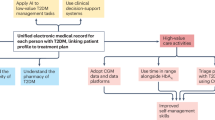Abstract
The position of both the body and the arm during indirect blood pressure (BP) measurement is often neglected. The aim of the present study was to test the influence of the position of the patient on BP readings: (1) sitting with the arms supported precisely at the right atrium level and (2) supine: (a) with the arms precisely at the right atrium level and (b) with the arms on the examination bed. In a first group of 57 hypertensive patients, two sessions of BP and heart rate (HR) measurements were performed in two positions: sitting and supine with the arms supported precisely at right atrium level in both positions. BP was measured simultaneously at both arms, with a Hawksley Random Zero sphygmomanometer at the right arm, and with an automated oscillometric device (Bosomat) at the left arm. BP and HR readings obtained in the two positions were then compared. In a second group of 25 normo- and hypertensive persons, two sessions of BP and HR readings were performed in supine with the arms in two different arm positions: (a) the arm placed precisely at right atrium level and (b) the other arm on the examination bed. The measurements were performed at both arms with two automated devices (Bosomat). The readings taken in the two positions were compared. Both systolic BP (SBP; by 9.5±9.0 (standard deviation, s.d.); right arm) and diastolic BP (DBP; by 4.8±6.0 mmHg; right arm) were significantly higher in the supine than in the sitting position. When the two different arm positions (body continously supine) were compared in the second part of the study, significantly higher SBP (by 4.6±6.1 mmHg) and DBP (by 3.9±2.8 mmHg) were obtained when the arm of the patient was placed on the bed (below the right atrium level), than when the arm was placed at the level of the right atrium. BP readings in sitting and supine positions are not the same. When according to guidelines the arm of the patient is meticulously placed at the right atrium level in both positions, the difference is even greater than when the arm rests on the desk or on the arm support of the chair. Moreover, in the supine position small but significant differences in BP are measured between arm on a 5 cm-high pillow and arm on the bed. In every study reporting BP values, the position of both the body and especially the arm should be precisely mentioned.
This is a preview of subscription content, access via your institution
Access options
Subscribe to this journal
Receive 12 digital issues and online access to articles
$119.00 per year
only $9.92 per issue
Buy this article
- Purchase on Springer Link
- Instant access to full article PDF
Prices may be subject to local taxes which are calculated during checkout

Similar content being viewed by others
References
Guyton A . Textbook of Medical Physiology. WB Saunders: Philadelphia. 1986.
1993 Guidelines for the management of mild hyper-tension: memorandum from a WHO/ISH meeting. Hypertension 1993; 22: 392–403.
Ramsay L et al. Guidelines for the management of hypertension: report of the third working party of the British Hypertension Society. J Hum Hypertens 1999; 13: 569–592.
Ljungvall P, Thorvinger B, Thulin T . The influence of a heart level pillow on the result of blood pressure measurement. J Hum Hypertens 1989; 3: 471–474.
O'Brien E, O'Malley K . ABC of hypertension. The patient. BMJ 1987.
Sloan PJ et al. Standardised methods for comparison of sphygmomanometers. J Hypertens 1984; 2: 547–551.
Terent A, Breig-Asberg E . Epidemiological perspective of body position and arm level in blood pressure measurement. Blood Press 1994; 3: 156–163.
Netea RT, Smits P, Lenders JWM, Thien T . Does it matter whether blood pressure measurements are taken with patients sitting or supine? J Hypertens 1998; 16: 263–268.
Zachariah PK, Sheps GS, Moore AG . Office blood pressures in supine, sitting and standing positions: correlation with ambulatory blood pressures. Int J Cardiol 1990; 28: 353–360.
Van der Steen MS, Pleijers AMLJ, Lenders JWM, Thien T . Influence of different supine body positions on blood pressure: consequences for night blood pressure/dipper-status. J Hypertens 2000; 18: 1731–1736.
Cavelaars M et al. Assessment of body position to quantify its effect on nocturnal blood pressure under ambulatory conditions. J Hypertens 2000; 18: 1737–1743.
Parati G . Blood pressure reduction at night: sleep and beyond. J Hypertens 2000; 18: 1725–1729.
Newton KM . Comparison of aortic and brachial cuff pressure in flat supine and lateral recumbent positions. Heart Lung 1981; 10: 821–825.
Hovinga G, Aarnoudse JG, Huisjes HJ . The effect of supine and lateral position on intra-arterial pressure in hypertensive pregnancies. Am J Obstet Gynecol 1978; 131: 233–238.
Villar J et al. The measuring of blood pressure during pregnancy. Am J Obstet Gynecol 1989; 161: 1019–1024.
Wichman K, Ryden G, Wichman G . The influence of different positions and Korotkoff sounds on the blood pressure measurements in pregnancy. Acta Obstet Gynaecol Scand 1984; 18: 25–28.
Netea RT et al. Influence of the arm position on intra-arterial blood pressure measurement. J Hum Hypertens 1998; 12: 157–160.
Author information
Authors and Affiliations
Corresponding author
Rights and permissions
About this article
Cite this article
Netea, R., Lenders, J., Smits, P. et al. Both body and arm position significantly influence blood pressure measurement. J Hum Hypertens 17, 459–462 (2003). https://doi.org/10.1038/sj.jhh.1001573
Received:
Revised:
Accepted:
Published:
Issue Date:
DOI: https://doi.org/10.1038/sj.jhh.1001573



